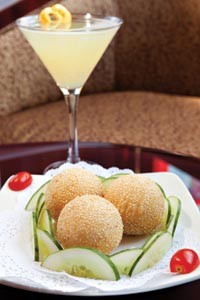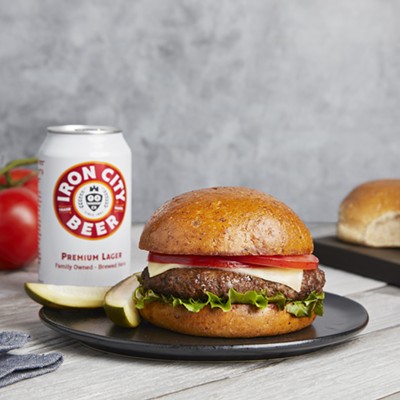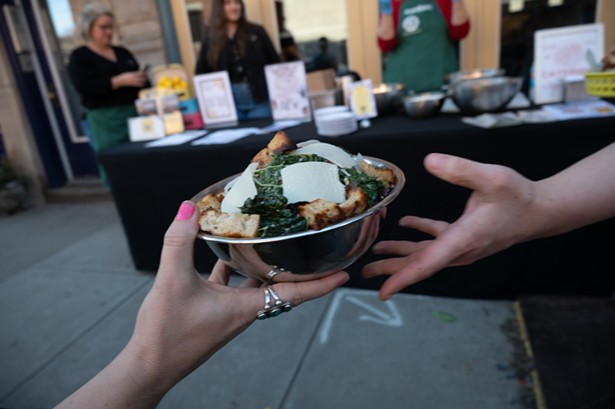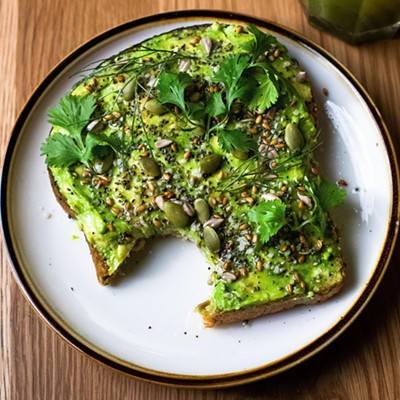Location: 1337 Old Freeport Road, Fox Chapel. 412-968-0848. www.jimmywans.com
Hours: Mon.-Thu. 11 a.m.-10 p.m.; Fri.-Sat. 11 a.m.-11 p.m..; Sun. 11:30 a.m.-9:30 p.m.
Prices: Soup, salad, dim sum and appetizers: $2-12; sushi $4-15; entrees $10-38
Fare: Chinese and Asian fusion cuisine
Atmosphere: Upscale Asian
Liquor: Full bar
Of all our Asian appetites, it's the one for good Chinese food that goes unsatisfied the most. So when our foodie friends from New York extolled a local Chinese restaurant called Jimmy Wan's, we said, "Where?" When they said Cranberry, we demurred -- Cranberry being only somewhat closer than China in terms of places we're willing to travel exclusively for a restaurant meal. But when we heard Jimmy Wan's had opened a new location in Fox Chapel, we said, "Let's go!"
Like the original, North Hills Jimmy Wan's, the Fox Chapel outpost offers an upscale ambience. Located just across Old Freeport Road from the Yacht Club, Jimmy Wan's features a swanky lounge, in a style that nods fashionably to old-school chop suey houses while feeling neither condescendingly kitschy nor painfully out of date. (The dining room, however, did make us wonder how a room with that much acoustic ceiling tile could be so noisy.) Similarly, the menu itself isn't Chinese in the sense of how one might experience food in China, but instead delivers what Americans expect from a Chinese restaurant -- and then some. Wan's modern, pan-Asian approach, complete with Japanese and French influences, begins with Chinese cuisine but certainly does not end there.
The menu is extensive but not overwhelming due to its clear organization into manageable categories. We were pleased to see that one of these was that rare commodity among local Chinese establishments, dim sum, of which we tried two as appetizers.
Shanghai soup dumplings are not dumplings made to put in soup, but soup contained within pouches of fresh dough, sealed and steamed, so that biting into the dumpling releases a mouthful of hot broth. Jimmy Wan's version was, unfortunately, disappointing. The dumpling wrapper was thick, even a little tough, and there was not much soup within. In the end, there was little to distinguish these soup dumplings from ordinary dumplings. On the other hand, Cantonese rice noodle rolls, consisting of thick noodles folded over their filling in the manner of Italian cannelloni, more than lived up to their "silky" menu description, and the filling of barbecued pork was superb.
We also ordered two other appetizers designated as such, both of which represented Jimmy Wan's tantalizing approach to fusing contemporary and traditional Chinese, European and American fare. Flash-fried salt-and-pepper calamari transformed a clichéd appetizer into something crispy and zesty, with dices of red and green pepper, jalapeño, ginger and garlic -- not a dipping cup of marinara sauce in sight. In fact, we would have liked it even zestier.
Sashimi ceviche was a colorful, flavorful mixture of salmon, tuna and escolar, "cooked" in fresh lime juice for a tangy Latin American take on the traditional Japanese plate of raw fish. Escolar has the robust character to coexist with the rich salmon and meaty tuna, and slices of ripe tomato and avocado emphasized the fresh flavors of this dish.
As you might guess by now, Jimmy Wan's sushi bar offers a range of traditional and creative combinations. We tried the volcano roll -- shrimp tempura topped with spicy tuna, tobiko (roe) and spicy aioli. The dish offered an enjoyable range of textures -- from delicately crispy to chewy to the popping-in-the-mouth of roe -- as well as the assertive spiciness of the tuna dressing and aioli.
The entrée menu featured less experimentation and a higher proportion of familiar Chinese-American dishes, like mu shu pork and Peking duck. Even here, though, there were a few surprises, including dan dan noodles, our favorite Sichuan dish to make at home. Until now we had never seen it in a restaurant, so of course we had to try. Consisting essentially of ground pork in a thick sesame sauce, Jimmy Wan's version was as rich as a good ragú. But it was brightened with scallions and -- in a welcome twist we'll be pirating for our home-cooked recipe -- julienned cucumber. The salty notes of soy dominated the sauce, but the well-browned meat and soft-but-not-mushy noodles made for a worthwhile dish.
Our other entrée, pork with black-bean sauce, delivered a broad array of textures, with still-crunchy shredded cabbage, juicy scallions and sautéed red peppers alongside ultra-tender strips of meat. Rather than being meek or overshadowed by stronger ingredients, the distinctive, tangy flavor of the fermented black bean sauce unified the disparate ingredients and carried this dish, an excellent example of Chinese-American restaurant cooking.
In this dish and others, we appreciated Jimmy Wan's willingness to showcase bold and unusual flavors. If this isn't Chinese cooking as it's done in China, then it's something we like just as much: exciting fusion cuisine close to home.
JR:

AB:













